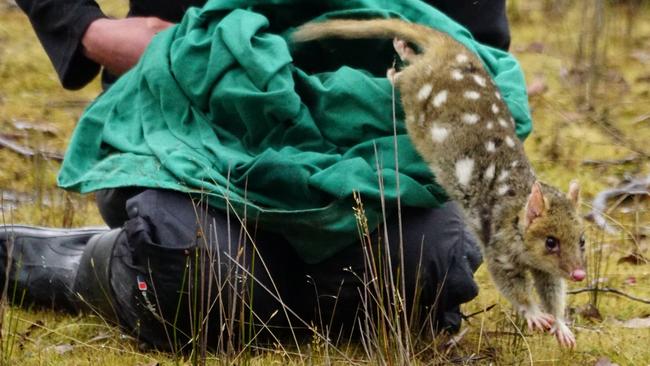Struggling eastern quolls to get a top-up
After the extinction of thylacines and decimation of Tasmanian devils, a new project aims to shore-up another troubled Tassie carnivore – eastern quolls.

After the extinction of thylacines and decimation of Tasmanian devils, a new project aims to shore-up another troubled Tassie carnivore – the eastern quoll – and mastermind their return to mainland Australia.
The eastern quoll, or EQ, a charismatic, spotted marsupial, was wiped out on mainland Australia mid-last century, and a recent study revealed declines of more than 50pc in its last stronghold of Tasmania.
To avoid another ecological tragedy, an alliance of researchers and wildlife parks – backed by the Australian Research Council – is attempting a new approach to conservation: early intervention.
The bold, almost $2m project will identify up to six areas in Tasmania where EQs are struggling and then top up these populations with captive-bred EQs.
A smaller trial at Silver Plains, in the state’s Central Highlands, has already shown the method can work, with high survival rates.
The lessons learned from this new larger project will then guide future attempts to reintroduce EQs to the mainland.
“A lot of conservation measures are kind of a triage, where the species has declined to such an extent that you don’t have much opportunity to learn,” said Dr David Hamilton, conservation ecologist with the Tasmanian Land Conservancy. “Whereas at this point we know that EQs are doing all right in some places and struggling in others.
“So one of the really valuable things about this project is we’re still able to get in and do a bit of science and experimentation.
“(We can) figure out what the best outcome for these animals is going to be before it gets to the point where it becomes ‘oh shit’ territory and there’s not enough left that we can do.”
The ARC is providing $970,000, with other partners – wildlife sanctuaries, the land conservancy, the WWF and the University of Tasmania – matching this in cash or in-kind support.
Team EQ will spend 18 months or so using remote cameras and trapping to identify the best sites, likely to be in the state’s east and midlands, where EQ declines are most severe.
They are holding up well in other areas, notably the Huon Valley and Bruny Island – a blessing, but one that can give a false sense of security.
“We’ve had enough issues in Tasmania with carnivores – the thylacine and the devil – and there’s an appreciation that we might have taken our eyes off the ball in terms of what’s happening with EQs,” said Dr Hamilton.
Attempts at reintroducing EQs on the mainland have not gone well, and it is hoped the five-year Tasmanian program will help shape future projects.
“This project is based around trying to untangle what the threats are to them in Tasmania and how we can best mitigate them,” Dr Hamilton said.
“Part of that pathway involves the translocation of individuals from captivity to supplement flagging populations. We can then use those captive-bred releases to try to figure out the threats in different regions and how we can best mitigate. That gives us fantastic licence for informing projects looking at reintroductions on the mainland.”
Threats include climate change – warmer, wetter winters are thought to impact prey – as well as competition from feral cats, and habitat destruction.




To join the conversation, please log in. Don't have an account? Register
Join the conversation, you are commenting as Logout